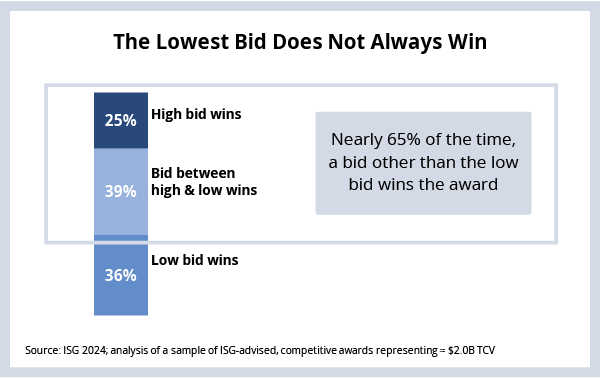Background
For those of you who have been reading the Index Insider for the last couple of years, you may recall that we revisit the “lowest bidder” research from time to time.
Each time, we look at a basket of ISG-advised managed services awards that involve multiple service provider bids on the same scope. For the analysis this year, the smallest award was $5 million total contract value (TCV). The largest award was $225 million TCV. The total TCV for the analysis was $2.0 billion.
As expected, the lowest bidder is (still) not always the winner.
The Details
- 36% of the time, the low bid wins; on average, the low bid is 22% lower than the next highest bid.
- About two-thirds of the winning bids that are not the lowest are within 20% of the low bid.
What’s Next
While 70% of enterprises indicate that cost optimization is a key source of funding for strategic initiatives today, this doesn’t always mean they are swayed by low bids on outsourcing agreements. That’s because most enterprises understand that if a bid is very low, it often signals that 1) the provider doesn’t understand the scope of work being outsourced or 2) they are trying to buy the business.
Both scenarios can result in poor service delivery in the long run as providers try to balance service delivery against lower-than-market margins, especially in the second or third years of an agreement. Experienced sourcing leaders understand this, which means very low bids are often eliminated early.
So, if being the lowest bidder is not a winning strategy for providers in competitive awards, what is?
First, it’s having market-aligned pricing. This is what differentiates providers with good pricing practices, because it enables them to stay within a price range that enterprises will accept but not leave money on the table. These are the winning bids that are within 20% of the low bid.
Second, it’s about having pursuit teams who listen to their clients and prospects and understand their risk tolerance and value drivers. When providers have a clear understanding of client expectations and scope – and market-aligned pricing – this creates a winning strategy.

